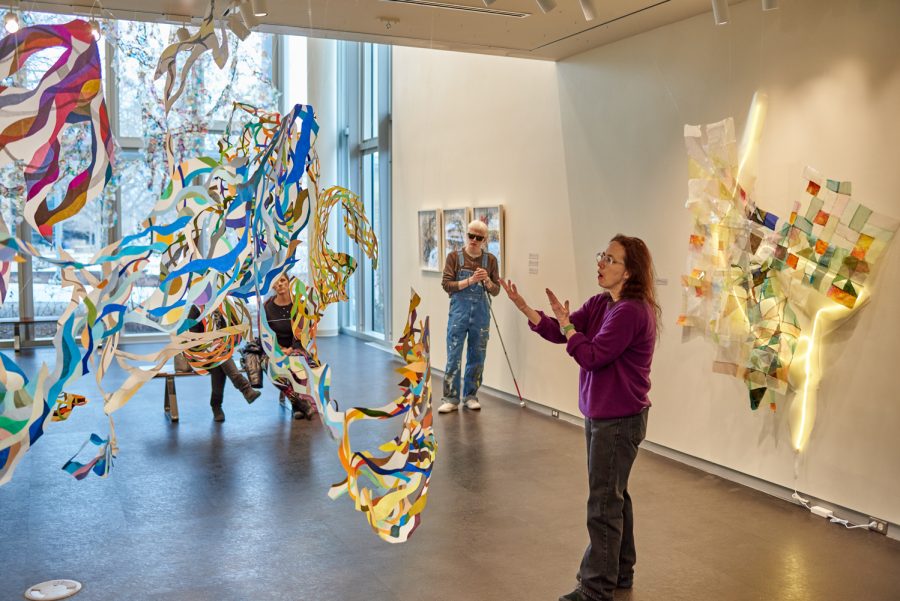‘Guardian of the Spirits’ gallery embraces femininity
Collegian | Reuel Indurkar
Holly Wong speaks about her art installation, “Guardian of the Spirits,” at the Curfman Gallery at Colorado State University April 4. “Some people ask me how I pick colors,” Wong said. “These are complementary colors. They are inspired from Chinese lion dance. You personify the animal. These are a personified, larger-than-life, female force. The colors are energizing and boundless. I’m interested in getting beyond gender.”
April 12, 2023
At 2 a.m., most people are fast asleep — but not Holly Wong. In fact, she just woke up. She is ready to start her day creating art while it is quiet and then, after a few hours, head out to her day job as a finance manager.
Holly Wong is a San Francisco-based artist whose art encapsulates femininity and remembrance of those who passed and persisted through tough times. All of these topics are on full display in her galley “Guardian of the Spirits” located in the Lory Student Center.
Wong initially fell into the world of art to cope with family difficulties in her youth, particularly the passing of her mother.
“In my sophomore year, I met Ed Love, who was the dean of the visual arts department at the New World School of the Arts, and he was a Black sculptor who was really phenomenal,” Wong said. “He was somebody that was an important force for me because he met me right after my mother died and helped me understand how art was a source of resilience, of healing and of processing of pain.”
In reflection on her mother being a victim of domestic abuse, Wong came to art in order to question why women specifically suffer these ways in society.
“It’s offering or connecting through the use of incense or food to make an offering to the dead. … The line between the living and the dead is very thin. And that’s why so many of my materials are transparent or luminescent because I do see that she is not far away. She’s with me, … so these pieces honor her presence, and they honor her spirit.” -Holly Wong, nontraditional installation artist
When Wong reached college, she recognized the history of female artists and how they are underrepresented in the world of art. Because of this, Wong focused on alternative histories and, most importantly, sewing and crafting.
“I felt marginalized in my own experiences,” Wong said. “I don’t think there was a consciousness about what it meant to be a woman making so-called women’s work.”
Although Wong felt the term “women’s work” was dismissive toward her, she eventually embraced it and began studying early American quilting. Reason being, she loved watching her mother cut fabric and patterns to create things. Wong aimed to reclaim that as a sacred action, therefore making much of her art approach a sacred process.
The significance of the name and the gallery as a whole strikes home and ties the whole gallery to one grand, overall meaning.
“’Guardian of the Spirit’ has to do with the notion that when my mother died, there were many things I didn’t know about her, and I felt like she was always a spirit force in my life but not something I could consciously feel a presence of,” Wong said. “The spirit is her, each LED-lit piece around the gallery (is) certain aspects of her and the LED light is a proxy for her body.”
Wong’s approach to her unique art style incorporates deep meanings of color and even the type of fabric she uses to create a much deeper and emotional message in her art.
“When you lose a loved one, there is a finality that you imagine,” Wong said. “But certainly in Chinese-American culture, the notion of somebody being dead and gone, it’s not really that. There is an ongoing conversation that people have with their relatives, and it’s often erroneously referred to as ancestor worship.”
Wong proceeded to explain the meaning and tradition of the ancestor worship.
“It’s offering or connecting through the use of incense or food to make an offering to the dead,” Wong said. “The line between the living and the dead is very thin. And that’s why so many of my materials are transparent or luminescent because I do see that she is not far away. She’s with me, … so these pieces honor her presence, and they honor her spirit.”
The gallery’s message revolves around her mother and also Wong’s own experiences as a woman.
“(The art pieces) are also a metaphor for my own female body,” Wong said. “Because a lot of what I went through as a woman in my 20s and 30s was about denial of the body. I became anorexic in my early 40s.”
Wong stated that cultures obsessed with misogynistic images affect the way women perceive their own bodies and often lead to restriction.
“I think that these pieces that are so large and floating and encompassing are all about taking space,” Wong said. “Because I think the first thing that women have to do is embrace their body. We are taught to deny our body. We are taught to be small. We must be small, we must not make a lot of noise, we must follow directions, and so these pieces are about taking that back.”
You can see the “Guardian of the Spirits” gallery for yourself through May 26 at the Curfman Gallery in the LSC.
Reach Christian Arndt at entertainment@collegian.com or on Twitter @CSUCollegian.









Barry Wright • May 1, 2023 at 5:04 pm
I think you meant to write ‘complementary’ colors.